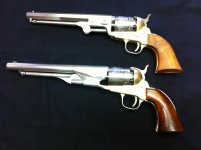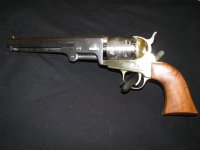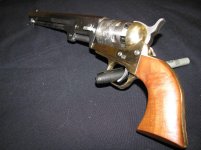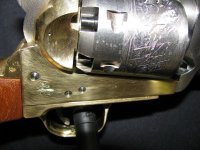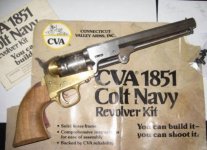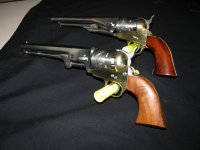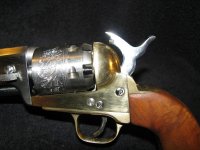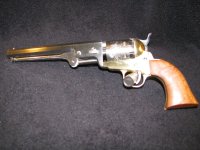Couldn't help myself.... I guess I enjoy learning while building and working on the guns. The price was right, and it was an 1851 Navy in the proper .36 cal, vs the 1860 Army in .44 that I bought already. I now have a lovely set of CVA revolvers in the proper caliber  . Both have cleaned up extremely nicely, and are still the original steel barrel with brass frames/trigger guard/backstrap.
. Both have cleaned up extremely nicely, and are still the original steel barrel with brass frames/trigger guard/backstrap.
I had to shape the grip on the Navy, sand/polish the rough brass, and remove the surface rust from the steel. Amazingly, the inner workings didn't require a whole lot of tuning - a burr removed from the bolt, a slight shave of the bolt sides where they lock into the cylinder, removal of burrs around the bolt hole in the frame, and a few burrs here and there on the frame. The hardest part was removing material from the arbor to allow the wedge to fit perfectly without causing the cylinder to bind.
The Navy actually cycles perfectly, whereas the damn Army is still giving me fits. I ordered a replacement bolt from DGW but haven't taken the time to install it yet. I spent the last 2 days working on the Navy getting it "ship shape" (sorry, couldn't resist).
I do have some questions for the experts...
Question#1 - You'll note the fine gleaming finish on the Army, and the dull finish on the Navy. I stained and waxed the grip on the Navy, but I would like the same gleaming finish on it that the Army sports. What should I use to "seal" it to achieve similar results?
Question #2 - On the Navy, the barrel stud is loose and does not make solid contact with the loading lever, allowing the lever to flop a bit. What can I do to seal the stud to the barrel, and perhaps tighten this gap?
Question # 3 - I would like to polish the hell out of the brass and steel to get them both super shiny (I like shiny). Suggestions on the best was to accomplish this? I used Emery cloth on the brass with good effect, but I apparently don't have a high/fine enough grit to really get it super smooth and shiny. I haven't touched the steel yet.
As always, help appreciated!
I had to shape the grip on the Navy, sand/polish the rough brass, and remove the surface rust from the steel. Amazingly, the inner workings didn't require a whole lot of tuning - a burr removed from the bolt, a slight shave of the bolt sides where they lock into the cylinder, removal of burrs around the bolt hole in the frame, and a few burrs here and there on the frame. The hardest part was removing material from the arbor to allow the wedge to fit perfectly without causing the cylinder to bind.
The Navy actually cycles perfectly, whereas the damn Army is still giving me fits. I ordered a replacement bolt from DGW but haven't taken the time to install it yet. I spent the last 2 days working on the Navy getting it "ship shape" (sorry, couldn't resist).
I do have some questions for the experts...
Question#1 - You'll note the fine gleaming finish on the Army, and the dull finish on the Navy. I stained and waxed the grip on the Navy, but I would like the same gleaming finish on it that the Army sports. What should I use to "seal" it to achieve similar results?
Question #2 - On the Navy, the barrel stud is loose and does not make solid contact with the loading lever, allowing the lever to flop a bit. What can I do to seal the stud to the barrel, and perhaps tighten this gap?
Question # 3 - I would like to polish the hell out of the brass and steel to get them both super shiny (I like shiny). Suggestions on the best was to accomplish this? I used Emery cloth on the brass with good effect, but I apparently don't have a high/fine enough grit to really get it super smooth and shiny. I haven't touched the steel yet.
As always, help appreciated!

